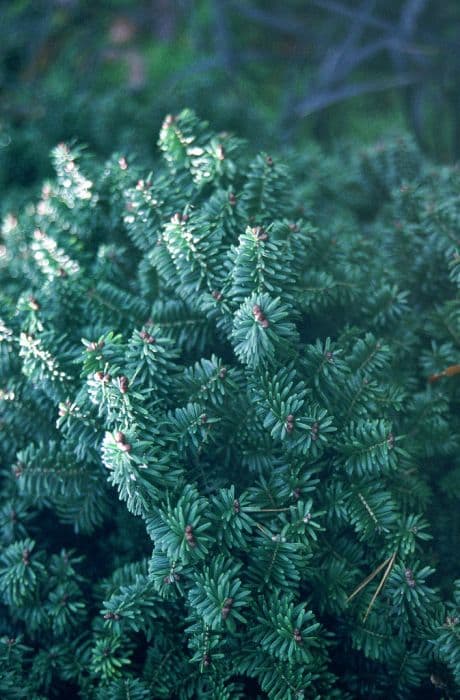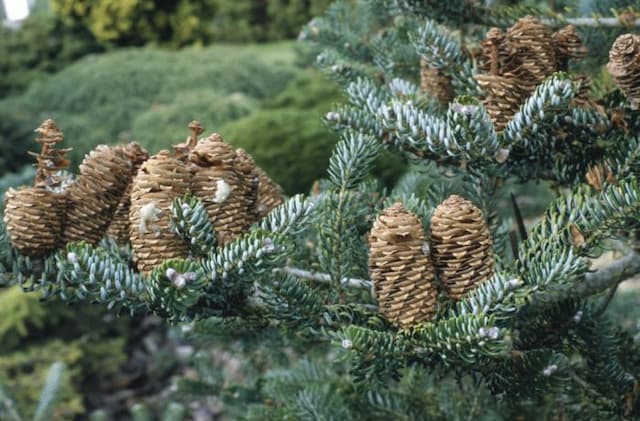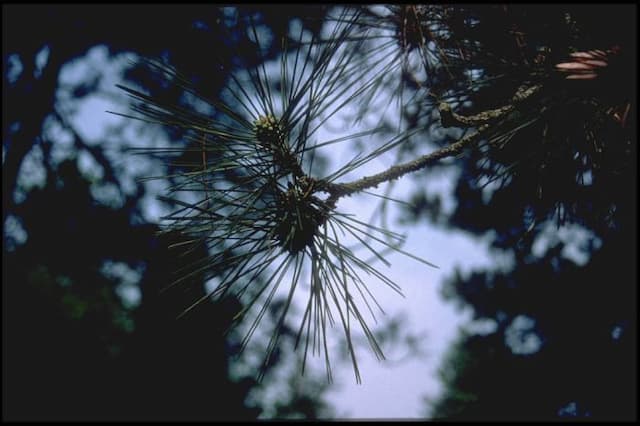Aleppo Pine Pinus halepensis

ABOUT
Commonly known as the Aleppo pine, this plant is characterized by its evergreen foliage, presenting a rich display of needles that possess a deep green hue. These needles are quite slender, typically grouped in pairs, which gives the foliage an overall dense and somewhat feathery appearance. The bark of the Aleppo pine is particularly noteworthy; when young, the plant exhibits a smooth grayish bark, but as it ages, the bark becomes rugged with a reddish-brown coloration that peels away in irregular plates or flakes. The branches of the Aleppo pine tend to spread outwards and upwards, often giving the plant a rounded or umbrella-like canopy that is irregularly shaped. During the spring months, the Aleppo pine showcases its reproductive structures with male cones being slender, small, and inconspicuous, whereas the female cones, which will mature into what we typically recognize as pine cones, start off with a green blush before hardening and turning a woody brown as they age. These pine cones are often oval or conical and can remain on the plant for several years before falling. The overall form and texture given by its branches, needles, and cones contribute to the Aleppo pine's distinct and recognizable appearance.
About this plant
 Names
NamesFamily
Pinaceae
Synonyms
Aleppo Pine, Jerusalem Pine, Mediterranean Pine
Common names
Pinus halepensis var. brevifolia, Pinus halepensis var. maritima, Pinus halepensis var. abasica, Pinus halepensis var. elatior, Pinus halepensis var. mediterranea, Pinus halepensis var. parnassica, Pinus halepensis var. relicta, Pinus halepensis var. taurica, Pinus maritima, Pinus tenuifolia, Pinus abasica, Pinus brutia var. stankiewiczii, Pinus ofukae.
 Toxicity
ToxicityTo humans
The plant in question, Aleppo pine, is not commonly known to be toxic to humans. Ingestion of parts of the plant normally doesn't lead to severe poisoning in humans. However, consuming large amounts of pine needles may cause gastrointestinal irritation or discomfort. Nevertheless, it's always recommended to be cautious and avoid ingesting plant parts unless they are known to be edible or used in traditional medicinal practices under the guidance of a professional.
To pets
The Aleppo pine is not specifically listed as toxic to pets. However, ingestion of pine needles can be potentially harmful to animals such as dogs and cats, as they might cause mild gastrointestinal upset such as vomiting or diarrhea. If a pet ingests a large amount of pine needles, it could potentially lead to an obstruction in the digestive tract, which could be serious and require veterinary attention. To ensure the safety of your pets, it is always best to prevent them from chewing on or ingesting parts of this or any other ornamental plants.
 Characteristics
CharacteristicsLife cycle
Perennials
Foliage type
Evergreen
Color of leaves
Green
Height
20-60 feet (6-18 meters)
Spread
20-40 feet (6-12 meters)
Plant type
Tree
Hardiness zones
8-10
Native area
Mediterranean
Benefits
 General Benefits
General Benefits- Erosion Control: The extensive root system of Pinus halepensis, commonly known as Aleppo pine, helps stabilize soil and prevent erosion.
- Shade Provider: Its dense foliage offers shade in hot climates, creating cooler microenvironments for humans and wildlife.
- Habitat for Wildlife: Aleppo pine provides habitat and nesting sites for various bird species and other wildlife.
- Reforestation and Afforestation: It is used in reforestation projects and afforestation to improve landscape quality and restore degraded areas.
- Ornamental Use: This pine species is often used in landscapes and gardens for its aesthetic appeal and evergreen nature.
- Timber and Wood Products: The wood of Aleppo pine is used for construction, furniture, and paper production, contributing to local economies.
- Recreational Use: Aleppo pine forests are popular for recreational activities like hiking, birdwatching, and enjoying nature.
- Cultural and Historical Significance: The tree has cultural and historical importance in many Mediterranean regions, often featuring in myths and traditions.
 Medical Properties
Medical Properties- Antiseptic: Essential oil from Pinus halepensis has been used for its antiseptic properties.
- Anti-inflammatory: The resin of Pinus halepensis is used for its anti-inflammatory properties.
- Antimicrobial: Extracts from the plant have been reported to have antimicrobial activity.
- Expectorant: Traditionally, Pinus halepensis has been used for respiratory conditions as an expectorant.
 Air-purifying Qualities
Air-purifying QualitiesThis plant is not specifically known for air purifying qualities.
 Other Uses
Other Uses- Traditional ink production: Aleppo pine's soot was historically used to make a black ink by mixing with gum arabic and water.
- Photography: The tree resin is used in special varnishes for protecting photographs and improving their longevity.
- Animal Feed: Needles of the Aleppo pine can be used as fodder for sheep and goats, especially during dry periods when other food sources are scarce.
- Wood Carvings: The wood of Aleppo pine, being fairly soft and easy to work with, is suitable for intricate carvings and handicrafts.
- Musical Instruments: The lightweight yet resonant characteristics of its wood make it a material of choice for crafting some traditional musical instruments.
- Tannin Extract: The bark contains tannins that can be extracted and used in the leather tanning process.
- Pine Nut Harvesting: Although not as commonly harvested as the pine nuts of other species, Aleppo pine does produce edible seeds that can be consumed.
- Soil Erosion Control: The Aleppo pine is planted to stabilize soil and prevent erosion in sandy and coastal environments.
- Christmas Trees: In some regions, small Aleppo pines are cultivated and pruned to serve as Christmas trees.
- Sailing and Rigging: Historically, the strong and flexible timber was used for masts and rigging in sailing vessels.
Interesting Facts
 Feng Shui
Feng ShuiThe Aleppo pine is not used in Feng Shui practice.
 Zodiac Sign Compitability
Zodiac Sign CompitabilityThe Aleppo pine is not used in astrology practice.
 Plant Symbolism
Plant Symbolism- Resilience - Pinus halepensis, commonly known as the Aleppo pine, is native to the Mediterranean region and known for its ability to thrive in harsh conditions, symbolizing resilience and adaptability.
- Longevity - Pines are often associated with long life due to their perennial nature, and the Aleppo pine is no exception, often living for hundreds of years, which can symbolize endurance and timelessness.
- Strength - The wood of the Aleppo pine is strong and has been used historically for building, representing strength and solidity.
- Peace - Pine trees in general have been seen as symbols of peace, and the evergreen branches of the Aleppo pine suggest tranquility and steadfastness.
 Water
WaterAleppo pines should be watered deeply to ensure the root system is thoroughly saturated, which generally requires about 10 to 20 gallons of water per tree every two weeks during the dry season. In areas with adequate rainfall, supplemental watering may not be necessary. However, during prolonged dry spells or drought, increase watering frequency. It's important to allow the soil to dry out slightly before watering again to prevent root rot. Young trees will need more frequent watering, about once a week, until they become established.
 Light
LightAleppo pines thrive in full sunlight, requiring a minimum of six hours of direct, unfiltered sunlight per day. They are best situated in an open space where they can receive unobstructed sunlight throughout the day to ensure healthy growth. Partial shade is not ideal for these sun-loving trees.
 Temperature
TemperatureAleppo pines are adapted to a Mediterranean climate and do well in temperatures ranging from about 20°F to 104°F, although they grow best when the temperature is between 65°F and 85°F. They can tolerate high temperatures and are quite drought-resistant once established, but young trees may need protection from frost.
 Pruning
PruningPrune Aleppo pines primarily to remove dead or diseased branches, which helps maintain the tree's health and appearance. Pruning is best done during the dormant season, in late winter or early spring, before new growth begins. It is not typically necessary to prune these trees heavily; light trimming every few years is sufficient.
 Cleaning
CleaningNot needed
 Soil
SoilAleppo pine thrives in well-draining, sandy or loamy soil with a pH range of 6.0 to 8.0. A mix of two parts sand, one part peat, and one part loamy garden soil is ideal for providing the drainage and aeration that Aleppo pine prefers.
 Repotting
RepottingYoung Aleppo pines should be repotted every 2-3 years to prevent root binding. Mature trees can be repotted less frequently, approximately every 4-5 years, as their growth rate slows.
 Humidity & Misting
Humidity & MistingAleppo pine tolerates a wide range of humidity levels and is well-suited to arid and semi-arid climates. It does not require high humidity and is adapted to dry conditions.
 Suitable locations
Suitable locationsIndoor
Ensure full sun and rotate pot for even growth.
Outdoor
Plant in full sun, well-draining soil.
Hardiness zone
7-11 USDA
 Life cycle
Life cycleThe life cycle of the Aleppo pine (Pinus halepensis) begins with seed germination, where conditions such as light, temperature, and moisture trigger the growth of the embryonic plant inside the seed. The seedling stage follows, where the young pine establishes roots and begins to develop its first true leaves (needles). As the pine enters the sapling stage, it continues to grow in height and girth, developing a woody stem and branches while also forming its characteristic needle-like leaves. The mature tree stage is marked by the Aleppo pine's capability to reproduce; it starts to produce cones after about 5 to 15 years, with male cones releasing pollen and female cones developing seeds. After pollination, female cones mature over a period of two years before releasing seeds that are often dispersed by wind. The Aleppo pine can live for several decades, continuing to grow and produce cones annually, and under favorable conditions, some individuals may live well over a century.
 Propogation
PropogationPropogation time
Spring-Early Summer
The Aleppo pine, or Pinus halepensis, is commonly propagated by seeds as it is a coniferous tree for which vegetative propagation methods are typically less successful. The best time to collect seeds is in autumn when the cones mature. To propagate by seed, the collected cones are dried in a warm, sunny area to allow them to open and release their seeds. The seeds should then be stratified, which is a process that mimics natural conditions to break seed dormancy. This typically involves keeping the seeds in a cold environment, around 34-41 degrees Fahrenheit (1-5 degrees Celsius), for about 60 days. After stratification, the seeds are sown in well-drained soil and lightly covered. They require full sunlight and regular watering until established.









